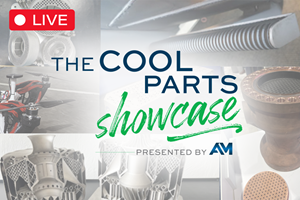Lithoz’s CeraFab Multi 2M30 Creates Multimaterial, Multifunctional Parts
Formnext 2023: The CeraFab Multi 2M30 is a lithography-based ceramic manufacturing 3D printer that can produce highly complex multimaterial structures by combining several materials — not only in varying layers of printed components but also within a single layer.
Share
Display of multimaterial parts (left to right): ceramic and polymer; pure copper and glass ceramic; hydroxy apatite and tricalcium phosphate.Photo Credit: INKplant
Lithoz’s CeraFab Multi 2M30 is a lithography-based ceramic manufacturing (LCM) 3D printer capable of combining different materials — such as ceramic with metal, ceramic with polymer or two different ceramics — in one single functional part and even within one single printed layer. In just one print run, entirely opposing material properties can be flexibly and functionally combined (such as conductive and insulating properties) creating the next generation of multifunctional parts providing previously unachievable detail and complexity.
The printer makes it possible to produce highly complex multimaterial structures by combining several materials not only in varying layers of printed components but also within a single layer. This machine eliminates the need for joining or assembly and makes it easy to replace assemblies with printed parts. It also enables freedom in geometrical design.
Powered by LCM technology, the CeraFab Multi 2M30 can manufacture multifunctional components for various applications, ranging from electronics and embedded sensors to biomedical implants and devices, as well as aerospace, automotive and energy storage systems.
Material combinations, unachievable using conventional technologies, enable two materials between and within layers, advanced composites and more. It is also an open system enabling manufacturers to develop their own materials. Automated cleaning step between material changes, with option to integrate own processes and software further expanding your range of capabilities.
The ready-to-use system consists of two vats, enhancing the speed, accuracy and effectiveness of a clean material switch between and within layers. It also includes a fully automated cleaning step to avoid cross contamination during material changes.
It is powered by CeraFab Control software. The company says special types of advanced composites with varying compositions and/or microstructures — known as functionally graded materials (FGMs) and functionally graded structures (FGSs) — can be produced, as well as complex multimaterial geometries unachievable using any other 3D printing technology. These new possibilities may pave the way for further innovation in industrial, medical and dental applications.
The company’s “ceramic AM factory” enables an array of parts for serial digital production produced by such manufacturers as Bosch Advanced Ceramics, Steinbach and SiNAPTIC, all using the Lithoz LCM CeraFab System printers. Some of these parts include natural-looking lithium disilicate dental restorations and bioresorbable ceramic implants made from hydroxy apatite. Also, multimaterial medical implants unite various bioresorbable materials, demonstrating the capabilities of bioceramics in a future where surgical precision, economic benefit and patient well-being can be brought together.
- Read about the Lithoz partnership with Himed for research on 3D-printable medical-grade bioceramics. This collaboration is designed to help grow the range of biocompatible materials suitable for a future that includes highly customized, patient-specific medical solutions that can be printed on demand.
- Learn about Lithoz’s collaboration with SiNAPTIC for ceramic additive manufacturing. The deal includes joint sales and marketing activities, as well as the purchase of seven Lithoz CeraFab S65 Medical printers for SiNAPTIC’s new research center in Lafayette, Colorado.
- Here are details about the Lithoz partnership with Zenit smart polycrystals’ materials for solid-state lasers. The collaboration includes alignment of Lithoz’s lithography-based Ceramic Manufacturing technology for the Zenit process, as well as support for market, organization and innovation strategies.
Related Content
Arburg Freeformer 750-3X 3D Features Larger Build Chamber
Formnext 2022: The Freeformer 750-3X 3D provides more space inside the build chamber for larger components.
Read MoreMeet The Cool Parts Showcase Winners
The Cool Parts Showcase winners for 2023 were announced at Formnext Forum Austin. Watch the award presentation here.
Read MoreFormnext Chicago Secures Premier Exhibitors for 2025 Event
Companies include some of the premier providers of additive manufacturing technologies as well as startup companies launching new materials solutions, capturing the entire spectrum of AM-related technologies.
Read MoreWhat We Found at Formnext 2023
New metal processes, new possibilities for existing processes, the next step for copper and more. Here is a summary drawing on all our reporting from November’s event.
Read MoreRead Next
4 Ways the Education and Training Challenge Is Different for Additive Manufacturing
The advance of additive manufacturing means we need more professionals educated in AM technology.
Read MoreAt General Atomics, Do Unmanned Aerial Systems Reveal the Future of Aircraft Manufacturing?
The maker of the Predator and SkyGuardian remote aircraft can implement additive manufacturing more rapidly and widely than the makers of other types of planes. The role of 3D printing in current and future UAS components hints at how far AM can go to save cost and time in aircraft production and design.
Read More3D Printing Brings Sustainability, Accessibility to Glass Manufacturing
Australian startup Maple Glass Printing has developed a process for extruding glass into artwork, lab implements and architectural elements. Along the way, the company has also found more efficient ways of recycling this material.
Read More






















